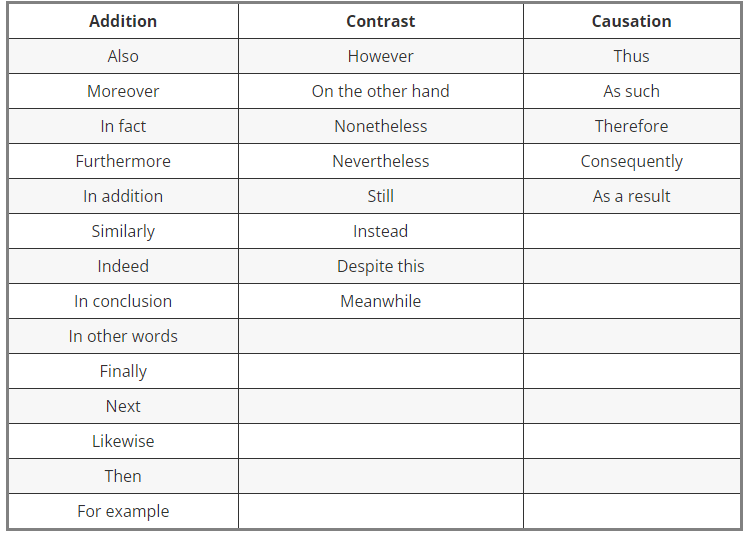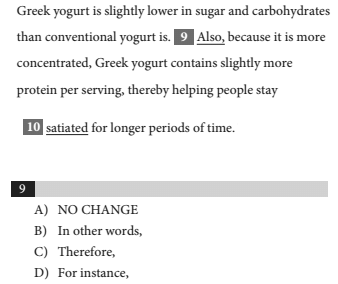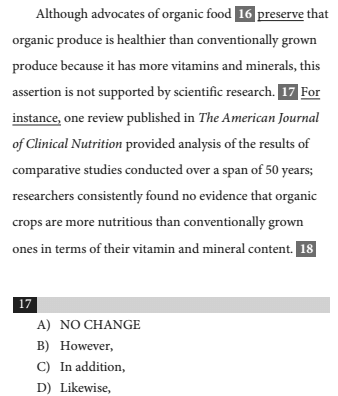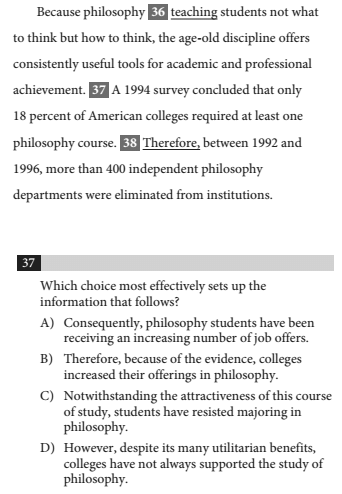Transition Questions on SAT Writing: Tips and Examples | Reading and Writing for Digital SAT PDF Download
| Table of contents |

|
| Type #1: Transitional Words |

|
| Key Transition Words |

|
| Type #2: Transitional Phrases and Sentences |

|
| Review: Key Strategies for Transition Questions |

|
What Are SAT Transition Questions?
There are two major types of transition questions. The first type will ask you to select the transition word that best completes a sentence. Examples of transition words include “moreover,” “therefore,” and “nevertheless.”The other type of transition question will ask you to select the phrase or sentence that most logically connects to or follows another part of the passage.
Type #1: Transitional Words
Selecting the right transitional word or phrase to complete a sentence requires you to understand how different transitional words are used. For the most part, transitional word questions on the SAT cover three basic transitional relationships: addition, contrast, and causation.- Addition: words like “furthermore” or “moreover” that continue or elaborate on a thought.
- Contrast: words like “despite” or “although” that introduce conflicting ideas.
- Causation: words like “since” or “because” that indicate a causal relationship.
Here are some example sentences. Pay attention to how the transition words make sense in context.
Addition: Making a Murderer is a riveting documentary. Also, it sheds light on the criminal justice system.
Contrast: Chris is an extremely popular singer. However, his voice isn’t very good.
Causation: Because the weather is warm, I’m wearing shorts today. 
Not every transition word falls into one of these categories, but thinking of transitions in these terms can help you correctly answer transition questions.
Most of the transition word questions will ask you to connect two sentences using a transition word. Here’s a basic example of this type of question.
Jeremy never studies. Also, he gets perfect grades on his exams.
A. NO CHANGE
B. Likewise,
C. However,
D. Therefore,
Because you wouldn’t expect somebody who never studies to get perfect grades, we need to use a contrast word. Answer choice C is the only one that makes sense in context.
Key Transition Words
These are the most common transition words divided by type. Familiarize yourself with the words on this list and their corresponding transition types.
How to Approach Transition Word Questions
Here's a step-by-step guide to help you correctly answer transition word questions.- Read Until the End of the Sentence: This advice goes for all SAT Writing questions. To ensure that you properly understand the context and are able to correctly determine the right transition word to use, you need to read the entire sentence to effectively determine the relationship between the sentences.
- Cross Out the Underlined Word: Next, cross out the underlined word. Otherwise, if you don’t immediately recognize an obvious error, you may be biased in favor of the original phrasing.
- Determine Which Word You Would Use: Decide which transition word you would use to connect the sentences. You may find that exact word or a synonym in the answer choices.
- Identify the Type of Relationship: Determine whether the sentences have an addition, contrast, or causation relationship. In rare cases, they may have a different relationship. If you’re not sure, think about whether you would connect the sentences with and (addition), but (contrast), or so/because (causation).
- Narrow Down Your Choices: Once you know what you’re looking for, eliminate the choices that don’t make sense or aren’t grammatical.
- Plug In Your Answer: When you think you have selected the right answer, plug it into the original sentence to make sure the transition is logical.
SAT Examples
Use the steps to answer the following SAT transition word questions.

First, we need to get rid of “also” and determine the relationship between the two sentences. The first sentence is talking about one benefit of greek yogurt compared to conventional yogurt. The next sentence lists another benefit of Greek yogurt; therefore, we can determine that we should use an addition transition word. “Also” is a perfect transition between these two sentences. The correct answer is A.
However, let’s look at the other choices to make sure. Answer choice B could only be correct if the second sentence provided an explanation of the first. Answer choice C could only be correct if the two sentences had a causation relationship. The second sentence would have to be a result of the first sentence. Answer choice D is wrong because that transition could only be used if the second sentence provided an example of the first sentence.
Let's try another SAT example of a transition word question:

Again, let’s remove the transition “For instance” and determine the relationship between the two sentences. The first sentence states that advocates of organic food believe that organic is healthier, but that’s not supported by scientific evidence. The second sentence cites a review that analyzed 50 years of studies in which researchers found no evidence that organic crops were more nutritious than conventionally grown crops. The second sentence provides an example that supports the claim made in the first sentence. Therefore, we need a transition that introduces an example.
Answer choice B indicates a contrast relationship and answer choices C and D indicate addition. The only answer choice that effectively introduces an example is answer choice A.
Type #2: Transitional Phrases and Sentences
The other type of transition question asks you to select the phrase or sentence that will most logically connect to the information in the passage. These questions will normally be phrased like this:- Which choice most effectively sets up the information that follows?
- Which choice most effectively sets up the information given at the end of the sentence?
- Which choice provides the most logical introduction to the sentence?
- Which choice most logically follows from the previous sentence?
Basically, these questions are going to be asking you to select the choice that sets up information or logically follows previous sentences.
Step-By-Step Approach to Transitional Phrases Questions
These are general steps because the specific steps you take will be dependent on the exact question that is being asked.- Pay Attention to What the Question is Asking: Make sure you’re answering the right question. Some questions may ask which choice sets up the information in the rest of the passage. Meanwhile, some questions may ask which choice sets up the information in the next sentence. You want to ensure that you don’t make a mistake because you misunderstood what the question was asking.
- Read What’s Necessary to Answer the Question: If the question asks you which choice logically follows from the previous sentence, you need to read the sentence in question and the previous sentence.
If the question asks which choice sets up the information in the rest of the passage, you need to at least skim the rest of the passage before answering the question. Furthermore, it may be helpful to skip the question and come back to it after you've answered the questions on the rest of the passage. - Keep in Mind Types of Transitional Relationships: Even though most of these questions don’t involve transitional words, it can be helpful to determine if there’s a clear contrasting, addition, or causal relationship.
- Summarize the Information That Is Being Referenced in the Question: Read and summarize the sentence or paragraph the question is asking about. For example, if the question asks which choice sets up the information that follows in the next paragraph, read the next paragraph and briefly summarize the information. Taking this step will allow you to more easily determine which answer choice sets up the information.
- Narrow Down the Choices: Eliminate answer choices that don’t logically set up the information or follow the previous sentence. The correct answer choice should make the sentences in question logically connect.
- Plug in the Choice You Think Works Best: After you’ve eliminated the choices you think are wrong, plug in the answer you’ve selected to make sure that it makes sense in context.
Real SAT Examples
Follow the steps I gave you to answer these SAT questions.
The question is asking for the sentence that sets up the information revealed in the final two sentences of the paragraph, starting with “a 1994 survey.” After reading the final two sentences, we can determine that the information demonstrates that colleges haven’t supported the study of philosophy or shown that they care about philosophy. We need to find a sentence that logically connects to this information.
Answer choice A has nothing to do with the information. There is no mention of jobs or job offers for philosophy students in those sentences. Answer choice B contradicts the information because philosophy departments were eliminated. Answer choice C has nothing to do with the information that follows. The information has nothing to do with students resisting majoring in philosophy. Answer choice D seems to be correct because it sets up the facts that a low percentage of colleges required philosophy and that 400 philosophy departments were eliminated.
After plugging in answer choice D into the paragraph, everything makes sense in context. The previous sentence mentions the usefulness of philosophy, which sets up the contrast indicated by “However” in answer choice D. The rest of the sentence starting with “colleges” sets up the facts that are revealed in the following two sentences. The correct answer is D.
Review: Key Strategies for Transition Questions
Here are the important strategies to use when you encounter a transition question on the SAT.
- Consider the Type of Transitional Relationship: For all transition questions, think about how the sentences are related. Knowing the relationship between the sentences in question are key to determining how to transition between them.
- Read the Question Carefully: For questions that are written out, make sure you understand what the question is asking. Also, read enough of the passage to understand the context and answer the question.
- Use Multiple Choice to Your Advantage: For transition word questions, if two answers are synonyms, neither is correct. Eliminate obvious wrong answers.
- Plug in the Answer You Think Is Best: Check your answer by plugging in the choice you think is best. The transition should make sense in context.
|
42 videos|31 docs|28 tests
|















